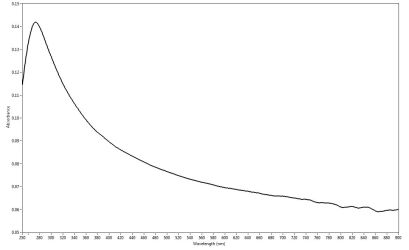Cellulosic Nanocrystals

Microspectrophotometers are used to analyze cellulosic nanocrystals and devices

Typical test spectra
Cellulosic nanocrystals and their optical effects can be studied with a microspectrophotometer.
Cellulosic nanocrystals are whisker-like materials formed from the most common organic polymer on Earth: cellulose. Crystalline cellulose has mechanical properties similar to that of other reinforcement materials while having a reactive surface on which functional groups may be added to yield different surface properties. Cellulosic nanomaterials can be made from readily available materials such as wood, plants, bacteria and algae. However, different source materials yield different types and shapes of cellulosic nanomaterials all of which can be optimized for different properties by bioengineering. Such cellulosic nanomaterials have unusual properties, which will be useful for for optics, electronics, nanotechnology and material science.
Microspectrophotometers are useful in the fields of material science and even nanomaterials. Absorption and emission microspectroscopy can aid in studying electronic and optical structure. And as these materials can be optimized for various optical effects, the engineering processes can be monitored by microspectroscopy. The major advantages of microspectroscopy are that these compounds can be studied in both solid form as well as a suspension. And with devices made with cellulosic nanocrystals, microspectrophotometers can even yield information about the thickness of thin films of cellulosic nanocrystals, their optical and electronic attributes, as well as the vibration characteristics by Raman microspectroscopy.
To learn more about microspectroscopy and cellulosic nanocrystals analysis and testing, select one of the following links:
What is a Microspectrophotometer?
Science of Microspectrophotometers


